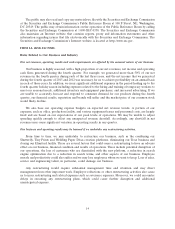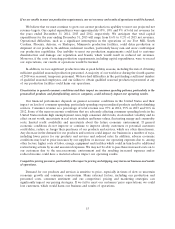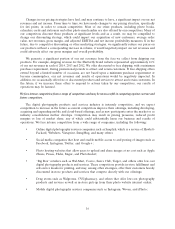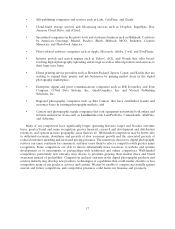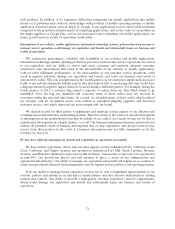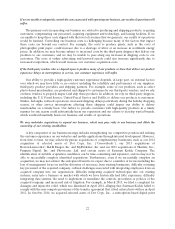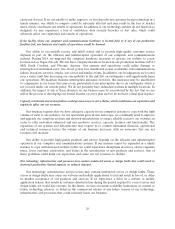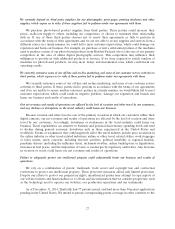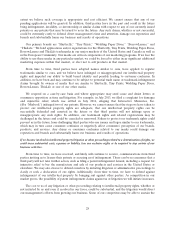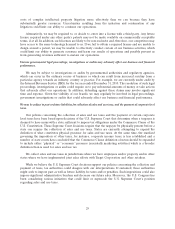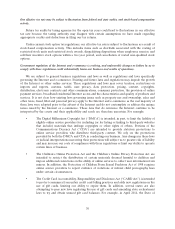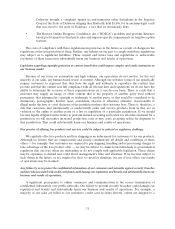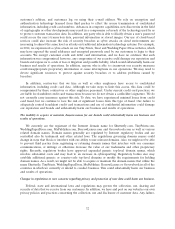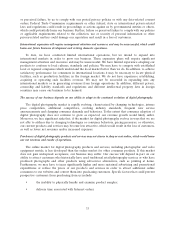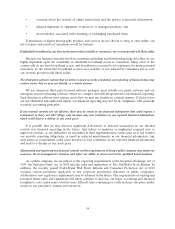Shutterfly 2014 Annual Report Download - page 25
Download and view the complete annual report
Please find page 25 of the 2014 Shutterfly annual report below. You can navigate through the pages in the report by either clicking on the pages listed below, or by using the keyword search tool below to find specific information within the annual report.whom we compete for qualified personnel. Accordingly, our ability to hire, retain, and motivate current
and prospective employees would be harmed, the result of which could negatively impact our business
operations.
In order to attract new personnel, we will need to grant inducement equity awards outside of our 2006 Equity
Incentive Plan, which dilutes the ownership of our existing stockholders.
Inducement stock options and restricted stock unit awards granted to new employees upon hire and in
connection with mergers and acquisitions in accordance with NASDAQ Listing Rule 5635(c) do not
require stockholder approval. Since 2007, the Board has approved inducement equity awards to
supplement our 2006 Plan for an aggregate of 1,951,561 shares of our common stock. The issuance of
additional shares of common stock may significantly dilute the equity interest of our stockholders and
could cause a change in control if a substantial number of shares of common stock are issued, which may
affect, among other things, our ability to use our net operating loss carryforwards, if any, and may
adversely affect prevailing market prices for our common stock.
If we are unable to attract customers in a cost-effective manner, or if we were to become subject to e-mail blacklisting,
traffic to our websites would be reduced and our business and results of operations would be harmed.
Our success depends on our ability to attract customers in a cost-effective manner. We rely on a variety
of methods to bring visitors to our websites and promote our products, including paying fees to third
parties who drive new customers to our websites, purchasing search results from online search engines,
e-mail and direct mail. We pay providers of online services, search engines, directories and other websites
and e-commerce businesses to provide content, advertising banners and other links that direct customers
to our websites. We also use e-mail and direct mail to offer free products and services to attract customers,
and we offer substantial pricing discounts to encourage repeat purchases. Our methods of attracting
customers, including acquiring customer lists from third parties, such as our acquisitions of customer lists
from Kodak, Fuji, American Greetings, Sony and Yahoo!, can involve substantial costs, regardless of
whether we acquire new customers. Even if we are successful in acquiring and retaining customers, the cost
involved in these efforts impacts our results of operations. Customer lists are typically recorded as
intangible assets and may be subject to impairment charges if the fair value of that list exceeds its carrying
value. These potential impairment charges could harm our results from operations. If we are unable to
enhance or maintain the methods we use to reach consumers, if the costs of attracting customers using
these methods significantly increase, or if we are unable to develop new cost-effective means to obtain
customers, our ability to attract new customers would be harmed, traffic to our websites would be reduced
and our business and results of operations would be harmed.
In addition, various private entities attempt to regulate the use of e-mail for commercial solicitation.
These entities often advocate standards of conduct or practice that significantly exceed current legal
requirements and classify certain e-mail solicitations that comply with current legal requirements as
unsolicited bulk e-mails, or ‘‘spam.’’ Some of these entities maintain blacklists of companies and
individuals, and the websites, Internet service providers and Internet protocol addresses associated with
those entities or individuals that do not adhere to what the blacklisting entity believes are appropriate
standards of conduct or practices for commercial e-mail solicitations. If a company’s Internet protocol
addresses are listed by a blacklisting entity, e-mails sent from those addresses may be blocked if they are
sent to any Internet domain or Internet address that subscribes to the blacklisting entity’s service or
purchases its blacklist. From time to time we are blacklisted, sometimes without our knowledge, which
could impair our ability to market our products and services, communicate with our customers and
otherwise operate our business. In addition, we have noted that unauthorized ‘‘spammers’’ utilize our
domain name to solicit spam, which increases the frequency and likelihood that we may be blacklisted.
24


